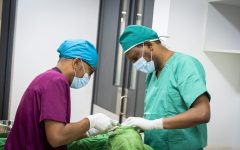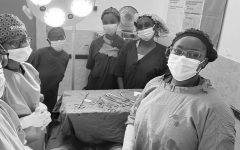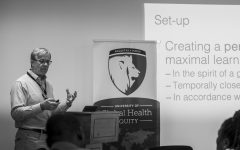One Health Field School – Students Share Their Experiences and Send Calls for Action
May 24, 2022 2022-05-24 10:18One Health Field School – Students Share Their Experiences and Send Calls for Action
The Master of Science in Global Health Delivery (MGHD) One Health Option at UGHE prepares students to respond to increasing complex health challenges. Every year, One Health Option organizes a One Health Field School that focuses on investigating and solving complex problems by developing leadership skills at the interface of different disciplines through applied system analysis and embedded experiences. The Field School provides innovative “feet-on-the-ground” learning experiences that embrace the intersection of cultural, social, economic, environmental, animal and health studies on communities-at-risk. This year, UGHE’s One Health students went on the field school from March 28th to April 1st, 2022.
Students visited different sites across Rwanda namely Welfare for Animals Guild Rwanda (WAG); Akagera and Volcanoes National Park; Rice Scheme and Vector Control Program; Rwinkwavu Wolfram Mining Site; Murundi Milk Collection Center (MCC); Inyange Industries; SABAN Slaughterhouse among others where they explored the interconnectedness of One Health Factors, opportunities and challenges in establishing a harmonious coexistence among humans, animals, and environment, and share calls to action to address the challenges and accelerate coexistence between humans, animals, and the environment that they share. MGHD One Health students discuss and share the challenges and opportunities anD send calls for action below.
Rice Scheme & Vector Control Program
Interconnectedness of human-animal-environment
The rice scheme has importance to humans, animals, and the environment. The rice scheme was established in 2016 by the Government of Rwanda and given to farmers in the cooperative of Indatwa Kayonza with zeal to protect the marshland that was deteriorated from individual farming. Collective farming is regulated and properly done to protect the marshland. For humans, the marshland of around 1146ha has been beneficial to grow rice (863ha) and maize (283ha). It is a source of income for farmers and the neighboring community, a source of loans through the cooperative and the bank for development activities, and a source of solar energy and modern cooking stoves. For animals, cattle benefit from having rice by-products as their feed.
Challenges and opportunities
The main challenge is the lack of knowledge, accountability, and collaboration between the Wolfram mining company and the cooperative in the rice scheme on the flow of water between the 2 sites which can endanger farmers, the community around the scheme, and their livestock, and aquatic animals. Water in the dam is in proximity to the mining site from which some water used to clean minerals is sent, this water then flows to the rice scheme. In the rice scheme, this water meets pesticides that are sprayed. In the scheme, farmers might drink it because there is no proximal source of clean water. From the scheme, the water flows toward Kageyo community. This community is located near the Akagera National Park. This community uses the water for their household chores and livestock feeding. The mining company denies that water from the site goes out into the dam. However, from our observation, water from the area where they clean minerals leaked toward the dam. The cooperative in the rice scheme accepts that some of their water goes into the environment and could have pesticides residues. However, they do not know that water leaks from the mining site to their rice scheme. This impedes any collaboration that can be done to tackle this issue.
The opportunity is that the rice scheme farmers are in a cooperative which would make the collaboration easier with the mining company compared to having individual farmers. The cooperative also understands its role in spraying pesticides in water that circulates toward the environment and Kageyo community. Another opportunity is that both sites work with the local leadership which was willing to help them perform better. This can be leveraged especially to raise awareness of the Wolfram mining company on water that leaks to the dam.
Call for action
There is a need for holistic collaboration in mitigating the water flow and enhancement of water treatment at the level of the mining site. For rice scheme pesticide spraying, buffer zones can be established, and awareness rose in the community for buffer zone respect. For rice farmers, health education on the proper use of personal protective equipment should be done to reduce exposure to pesticides and other aforementioned risks. Second, there is a need for One Health research to understand the possible presence of pesticide residues and heavy metals presence in humans, animals, and the environment. This would inform interventions to the water flow problem. Thirdly, proper WASH infrastructure should be established near the rice scheme to mitigate open defecation, drinking of unsafe water, and reduce Schistosomiasis prevalence which was as high as 42% (according to the Rwanda Biomedical Centre). These interventions would need collaboration between the Ministry of Agriculture (MINAGRI), Ministry of Environment (MoE), Ministry of Health (MINISANTE), Ministry of national natural resources in Rwanda (MINIRENA), local leaders, rice farmers’ cooperative, the mining company, researchers, among others.
Rwinkwavu Wolfram Mining Site
Interconnectedness of human-animal-environment
Rwinkwavu wolfram mining and processing site operates on 8250ha of land that spans 6 sectors of Kayonza district of the Eastern province of Rwanda. The main mineral extracted is Tin, but there are other minerals found on the site such as Tungsten, Iron, Niobium, Titanium, and others. The site employs about 1236 people including part-time and full-time employees from nearby communities and other areas.
Kayengeri is one of the areas where there is an underground mining tunnel. The site is an illustration of the interconnectedness among humans, animals, and the environment as the health of the mineworkers, animals, and the environment of the nearby communities is directly or indirectly affected by the natural resources available in the area. The lifestyle of the humans affiliated with the site has been improved by the earnings from the site. The earnings could be used for different purposes including gaining purchasing power for food, health insurance and healthcare and services coverage, education, and proper housing and other basic needs. For instance, a mineworker on average earns two to three thousand Rwandan francs per day from the site, and the company running the site has built a primary school, road infrastructures, and houses for the poor in the community. These all work together to ensure improved social determinants of health and the well-being of humans and their livestock, and the environment they live in. In addition, animals like cattle and other ruminants depend on the mining site environment for food (grass) and water, and wild animals and other species in the ecosystem use the environment for shelter. The environment depends on humans and animals to keep the ecosystem balance and health. The mining activities could pollute the environment and break its balance leading to diseases in both humans and animals as vectors lose their habitat and come into proximity with communities and as humans and animals interact with the mining environment which exposes them to vectors and mineral pollutants on a daily basis (Kitula, 2006; Macháček, 2020).
Challenges and opportunities
The site faces different challenges that involve humans, animals, and the environment. The site is open access, it has no fence that separates it from the communities around. This leads to open grazing of animals at the site, and even if none was observed on the day of our visit, it was confirmed by the mineworkers. Multiple open pits where minerals were washed were observed in the area with abundant stagnant water from which mosquitoes could breed and transmit malaria to the mineworkers. At the site, some employees lacked protective equipment like face masks, however, almost every employee observed wore rubber boots and a helmet. The employees reported some occupational accidents and diseases like silicosis that sometimes occurred on the site due to unstable mining infrastructure and lack of protective equipment and lack of regular medical checkups respectively. Also, there was water runoff from mineral washing and sorting tables to the surrounding environment. Furthermore, it has been reported that mining activities destroy agricultural and grazing lands and pose disturbances to livestock keepers and farmers (Kitula, 2006).
Call for action
There is a need to raise awareness of occupational hazards among miners and safe practices so that they understand the danger they could face once at the mining site. Most of the miners don’t use appropriate protective measures, therefore the provision of personal protective equipment is essential to avoid exposure to chemical agents. In order to control diseases miners are exposed to, there is a need to promote surveillance and regulation by both national and local governments. More measures can be taken such as promoting water recycling systems efficiently at all mining sites, constructing stable infrastructure to avoid accidents and regular medical screening for all workers to rule out different medical conditions such as Silicosis and mercury poisoning. Gender equality is very crucial, therefore, there is a need to increase the number of women employed by mining companies. Ministry of natural resources, Rwanda geology and mining authority, Ministry of health, the Ministry of environment, and the Wolfram mining company should be involved in the implementation of such interventions to reduce exposure to occupational hazards in the mining sector and to protect the environment, animals and the humans living in the surrounding communities.
Murundi Milk Collection Center (MCC)
Interconnectedness of human-animal-environment
At the MCC, students learned how milk was handled, collected, tested, stored, and distributed in rural areas of Rwanda. Each of these steps has human, animal, and environmental health components, but milk handling and testing will specifically be analyzed in this response. Cow health is negatively impacted by bovine mastitis and its bacterial causal agents like Staphylococcus aureus and E. coli (Abebe et al., 2016). These bacteria can cause inflammation and milk changes in cows as well as having the potential for zoonotic spread to humans through drinking contaminated milk (Abebe et al., 2016). To treat the cow and prevent zoonotic bacterial spread, animals are treated with beta-lactam and tetracycline antibiotics (Pascu et al., 2022). While useful, these antibiotics can also be present in milk, which contributes to antibiotic resistance if humans drink the milk that has sub-therapeutic levels of antibiotics (Pascu et al., 2022); rural farmers are at risk since they save some of the raw milk for themselves. In the field, students heard how more antibiotics are used and needed during the dry season in Rwanda because there are more infections at that time. The higher number of infections could be due to harvest and feeding challenges during the dry season, which is increasing in length due to climate change, an environmental health issue (Habiyaremye et al., 2021).
Challenges and opportunities
The challenges seen at the MCC include poor transportation, infrastructure, and hygiene. Regarding transportation, a farmer stated that roads are their overall primary concern because if milk is at higher risk for rejection when traveling for long periods of time. The farmer reported his journey from the farm to the MCC as taking 45 minutes during the dry season on a moto. During the rainy season, he said there is no way to get to the MCC. Regarding infrastructure, more expensive, technically advanced equipment for milk testing was not used because it either did not work and replacement part is not located in Rwanda, or the results took too long to analyze. Additionally, there are no aflatoxin tests at the MCC, so while Inyange can do that, not all the milk goes to Inyange, but also to local consumers and farmers themselves.
In addition to the challenges described above, the main OH challenge at the MCC was related to hygiene and risk of bacterial growth and infection spread. First, one container of milk was stored in a blue plastic tank, increasing risk for bacterial growth and milk spoilage. Second, milk collection equipment was left in the open, and the top of a milk container lid was lying on ground, increasing the risk of microbial introduction into the milk. Potential interactions between human health and milk safety were also present: there were hygiene issues related to sanitation and using the toilet. The sanitation infrastructure was visibly dirty, and handwashing services were inadequate. Meanwhile, bare hands were used for the thermometer and lacto-densimeter, as well as to reconnect the broken equipment, lying on the ground, causing milk spillage.
While there were challenges at the MCC, there was also a success story; over the past few years, there have been large reductions in the use of plastic water jugs to transport milk. The material and shape of the water containers are hard to clean and can’t keep the milk at a consistent temperature.
These factors allow for a large growth of pathogens, themselves which thrive in milk due to the nutrients, and bacterial wastes spoil the milk. This story provides hope that hygiene challenges can be improved in the future.
Call for action
To address poor transportation, infrastructure, and hygiene at the Murundi MCC, climate change adaptation, more efficient technologies, and improved water, sanitation, and hygiene (WASH) services and behaviors are needed. First, landslides during the rainy seasons make transportation from farm to MCC difficult for milk transporters; therefore, climate change adaptation measures like rainwater storage tanks and traditional drainage systems could be useful (Rwanda Water Portal, 2016). Second, more efficient milk testing technologies are essential, as high-tech equipment may be useful in other settings, but current constraints are limiting their effectiveness at the Murundi MCC. Therefore, the Ministry of Agriculture and Inyange should ask MCC employees about which technologies would be beneficial, pilot test these technologies, and follow up on their use and success. Third, WASH services and health behavior require improvement; therefore, more accessible services are needed in conjunction with investigating the reason why personal protective equipment (PPE) like gloves are not used.
All three actions can be accomplished through systems changes rather than individual interventions. The Dairy Dynamic Management (DDM) model provides a framework for addressing the human, animal, and environmental drivers of MCC challenges through interdisciplinary approaches (Garcia et al., 2019). For example, dairy workers, a scientific consultant (researcher), dairy managers/owners (MCC employees), and a DDM specialist (a One Health expert) could collaboratively identify the root causes of poor WASH services and behaviors and subsequently address them. MCC workers may describe that there are time and resource constraints, such as the non-use of gloves due to their non-availability. On the other hand, gloves may impede MC work, which was reported at SABAN Slaughterhouse. After obtaining root-cause information, the scientific consultant could show stakeholders the risks of poor sanitation in the MCC, and the One Health expert could implement the collaboratively identified solution.
Welfare for Animals Guild Rwanda (WAG)
Interconnectedness of human-animal-environment
The Welfare for Animals Guild Rwanda (WAG) is a non-profit, volunteer-run initiative dedicated to improving the lives of dogs in Rwanda. The organization’s work is a good example that demonstrates the interconnectedness and interdependence of the health of humans, animals, and the environment. WAG rescues, rehabilitates, and rehomes abandoned dogs. These are dogs who would otherwise remain strays within the community posing risks to their health and the health of the community and environment.
Stray dogs play a role in the transmission of zoonotic diseases such as rabies, risking the health of humans. They further risk lives through traffic accidents, bites, and transmission of other infections. They also pose a risk to the health of other dogs, domestic animals, wildlife, and livestock. Additionally, these animals impact the environment as they also play a role in pollution through their excreta and the noise they make in the community (OIE, 2016).
It is also important to note that the primary cause of stray dogs is abandonment by human owners, showcasing the relationship between human behavior and the well-being of the dogs. Furthermore, the environments where stray dogs gather are usually areas where rubbish is readily available as a source of food for the dogs. Therefore, the status of environmental sanitation impacts the dogs and their health.
WAG promotes animal welfare and serves as an important resource for pet owners, human-dog population management, and responsible pet ownership with the understanding of the relationship that links the health of humans, animals, and the environment.
Challenges and opportunities
The main challenge faced in establishing a harmonious relationship between humans, dogs, and the environment is the lack of awareness among humans, the lack of population control, the lack of good sanitation, and the lack of a database on the status of these problems. Fortunately, all the challenges mentioned here are amendable and serve as an opportunity to create an environment within which humans and animals can live.
The win-win relationship established through dog ownership provides an opportunity to build a harmonious coexistence between these friendly canines and their owners. The work that WAG is doing leverages this opportunity to bring humans and animals together for a mutual benefit. Such relationships existing on a larger scale can lead to fewer stray dogs in the community, improving the environment. Removing stray dogs through rehoming assures a community where dogs are cared for while protecting the environment and humans from the risks that stray dogs pose.
Furthermore, another challenge faced is too many stray dogs due to the nature of the high number of puppies born on the street. This problem is an opportunity that serves as an entry point to implementing population control.
Call for action
The interventions that must be implemented to address the issue WAG is dealing with, primarily stray dog problems, should be a One Health intervention. The most feared infection that could infect stray dogs and consequently humans is rabies, a zoonotic viral infection that is vaccine preventable (WHO, 2021). The primary solution for this infection is prevention through the vaccination of dogs. Furthermore, population control through spaying and neutering of stray dogs while concurrently administering vaccinations will protect the health of the dogs and minimize a significant risk to humans, other dogs, and other animals. Conducting awareness creation among the community about proper dog ownership is also among the main call to action that should be implemented. Maintenance of proper waste disposal will prevent the collection of dogs in areas looking for feeds decreasing the number of unnecessary human-animal-environment interactions. Finally, building a comprehensive database on the status of stray dogs, including mandatory registration of pet dogs, will facilitate the design of a successful intervention that benefits all.
Akagera National Park (ANP)
Akagera National Park is the largest protected wetland in Africa and was founded in 1934 under the throne of king Mutara III Rudahigwa. (Bwiza.Com, 2016) It is now managed by African Parks (AP), a non-profit organization from South Africa that manages protected places with the governments and communities. (African Parks, 2022) This park is in the Northeast of Rwanda and borders Tanzania. Initially, the park had a surface area of around 25,000 square kilometers. However, due to the Rwandan refugees who were coming around 1997 from exile in neighboring countries, the government had to take up to 50% of the park’s surface area for the resettlement of those Rwandan citizens.
This park is growing in terms of biodiversity as white rhinoceros and black rhinoceros were reintroduced from South Africa in 2017 and 2022, 22, respectively. ANP also received seven lions still from South Africa in 2015, and since the population has grown to over ten lions. The park has around 250 workers, excluding the casual workers that include around 80 freelance guides from the local community. The park attracts an increasing number of tourists each year from different places around Rwanda and abroad, as well as 5,000 from local communities each year. To manage this, the management limits the number of cars entering the park per day to 40 cars to ensure limited environmental disruption.
Challenges and Opportunities
Through our time in Akagera National Park (ANP) and through conversations with staff working in Volcanoes National Park (VNP), it became clear that park leaders are constantly trying to balance the interests of local communities, tourists, conservationists, and private stakeholders. In VNP, park leaders have narrowly focused marketing efforts on gorilla tracking and tourism. While some of the funds generated by tourism are used for conservation, the resources are often only used to protect the gorillas, not to conserve the greater ecosystem that is required to support their population. This human and animal ecosystem is also degraded by tourist activities through the pollution of the environment and land-use disruption of traditional agricultural and hunting land-use practices. These challenges require a reconsideration of how the interests of tourists, conservationists, and locals are balanced.
Although the reintroduction of lions and rhinoceroses into ANP has generated a great deal of tourist revenue for the park, the park staff have decided not to offer game-tracking safaris for tourists. Instead, the park offers game drives, which follow a set course of roads throughout the park and limit the exposure of endangered animal populations to humans. The choice to prioritize the conservation of animal habitats over the interests of the tourists may inhibit the park’s income, yet it aligns with the park’s mission of pragmatically preserving the integrity of the Akagera ecosystems. As a member of the African Parks coalition, ANP has a clear platform to disseminate the tenets of their approach of balancing the interests of conservation with tourism to national parks that face similar challenges in the region. Although the leadership of ANP and VNP have vastly different approaches to conservation, they share the potential to learn from each other’s successes and opportunities for growth, as each serves as a steward for ecosystems that are critical to the proliferation of endangered species, local communities, and surrounding economies.
Call to action
Ecotourism- to maintain the economic activity generated by tourism that benefits the communities surrounding parks and the conservation of species within the park, park stakeholders could shift tourist activities to apply the principles of ecotourism. Ecotourism is the “responsible travel to natural areas that conserves the environment, sustains the well-being of the local people, and involves interpretation and education” (ecotourism.org, 2022). Rather than solely provide activities focused on gorillas in VNP or the big five in ANP, park officials and tourism companies can promote the beauty and uniqueness of the greater park ecosystems. By advertising the diversity of activity options within the parks, like hiking, mountain biking, or bird watching, the park may be able to attract a broader range of visitors who are satisfied with their park experience without engaging in the gorilla or big five tourism. Community-based experiences, like basket weaving workshops or farm tours, can bring revenue to locals while fostering a sense of respect for locals among tourists.
Involving the local community in the management of the park. Having the local people in the management positions can make it easier in engaging the community in biodiversity conservation than having those people from outside teaching them how to and what to do. And it helps them as well to trust the management as there are their daughters, or sons in the team. If it is a land to be protected people can easily understand it easily and take it as something beneficial than harmful to them because they trust their people in the management team.
***
Watch the One Health Field School Video Highlight Here.











